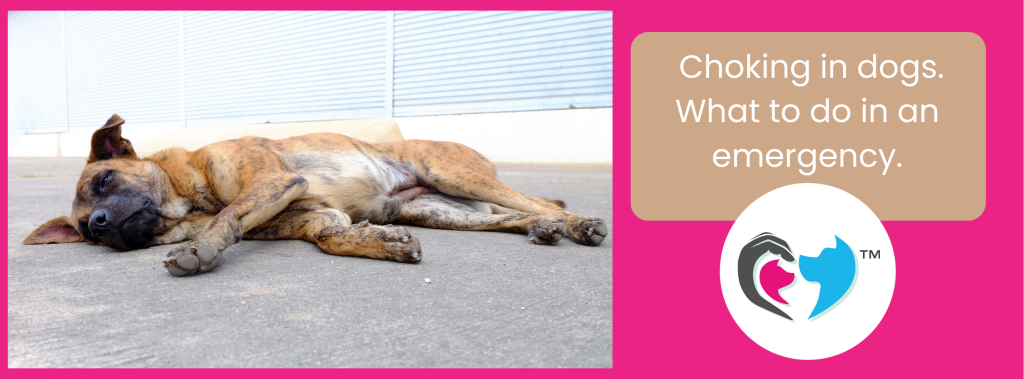

Emergencies can strike suddenly, often leaving us overwhelmed and unprepared. When it comes to our pets, these moments can be especially stressful. One such urgent situation is choking, which can escalate rapidly and become life-threatening. As pet owners, it is essential to be informed and ready to act.
What Causes Choking in Dogs?
Dogs are natural scavengers and tend to pick up objects from the ground indiscriminately, much like a vacuum cleaner. Choking occurs when a dog’s airway becomes blocked, preventing them from breathing properly.
Common causes of choking include:
In veterinary practice, the most frequently observed causes are bones lodged in the mouth or throat, or small balls that become stuck behind the tongue or at the back of the throat.
Signs of Choking in Dogs
Recognising the early signs of choking is crucial. It’s not uncommon for pet owners to confuse coughing or gagging with choking. If your dog is choking, you may observe the following:
Conditions That Mimic Choking
Certain medical conditions, such as reverse sneezing, can resemble choking and may sound alarming, but they are not a cause for concern. The dog looks uncomfortable, making a loud snorting or gagging sound when they rapidly inhale air through their nose. This usually resolves on its own and is often caused by inflammation or allergies in the back of the nose. Though unsettling, reverse sneezing typically resolves on its own. However, persistent episodes should be evaluated by a veterinarian to rule out nasal infections or foreign bodies, such as grass seeds stuck in the nasal cavity.
Other health conditions that may present similarly include:
What to Do if Your Dog is Choking
If you suspect your dog is choking, remain calm. Panic can increase your dog’s anxiety and worsen the situation. If your dog is cooperative, gently check their mouth for visible obstructions. If an object is clearly visible and not deeply lodged, you may attempt to remove it with caution, being extremely careful not to get bitten or accidentally push the object deeper.
Avoid blind finger sweeps at the back of the throat unless absolutely necessary. This technique can cause you to get bitten, or you can accidentally push the object deeper into the throat, which can lead to complete obstruction of the airway. A technique known as the External Extraction Technique (XXT) has gained popularity on social media. It is a technique to remove a foreign object that is deeply lodged in the airway of an unconscious dog. It involves applying pressure to the trachea using a specific hand position to dislodge deeply embedded objects. This technique can be effective, but it is highly technical and best left to those with appropriate training to prevent any further injuries.
When to Perform the Heimlich Manoeuvre
If the dog is unresponsive or struggling to breathe with no air movement, you may need to perform the canine Heimlich manoeuvre. The goal is to apply sufficient pressure to the diaphragm to facilitate the expulsion of air from the lungs and dislodge any obstruction. The method varies depending on your dog’s size:
Heimlich Manoeuvre for Small Dogs Gently place your dog on their back while sitting them on your lap. Using the palm of your hand, apply firm pressure just below the rib cage and push inward and upward in quick, thrusting motions, repeating this motion five times. Afterwards, carefully roll your dog back onto their side and check their mouth for the object that was causing the choking.
Heimlich Manoeuvre for Medium and Large Dogs:
If your dog is standing:
Stand behind your dog and wrap your arms around their body so that your hands meet just below their rib cage. Form a fist with one hand and place it in the soft part of the abdomen, then use your other hand to grip the fist. Perform five quick, firm thrusts in an upward and forward motion, similar to how you would perform the Heimlich on a person. This action is intended to dislodge the object from the airway.
If your dog is lying down:
Position one hand on your dog’s back for support and place the other hand on their abdomen. Apply firm pressure upward and forward toward the spine in a thrusting motion. Repeat up to five times, then check the mouth to see if the object has been dislodged. Be sure to remove any loose debris to prevent your dog from re-inhaling or swallowing it. If you are unable to dislodge the object, take your pet to the vet as soon as possible.
Rescue Breathing and CPR
If your dog passes out due to being unable to breathe, you can perform rescue breathing by manually blowing air into their lungs. Start by aligning the head and neck with the dog’s spine to prevent the risk of further blocking the airway. Hold your dog’s mouth closed and breathe into their nose until their chest expands. Give one breath every 5 seconds until you reach the closest vet.
If your dog’s heart stops beating, due to the airway obstruction, you will need to administer CPR until you reach the vet, to give your dog the best chance of survival. There are different methods for administering CPR, depending on the size of the dog.
· Small dogs: place your dog on their right side and squeeze the chest between your thumb and fingers.
· For barrel-chested dogs with a wide and round chest, it is better to place them on their back. Using the heels of your overlapping hands, press down on the flat vertical bone in the centre of the chest (sternum).
· Medium to large dogs: place your dog on his/her side. Overlap the heels of your hands over the widest point of the chest. It is essential to keep your elbows locked. This will help you produce the appropriate pressure and help prevent fatigue.
Perform 5 cycles of 30 chest compressions, followed by 2 breaths. Reassess for breathing every 2 minutes.
If you were able to remove the object, you still need to visit the veterinary clinic to make sure that everything is removed and that no damage was caused.
How to Prevent Choking in Dogs
While not all emergencies can be avoided, there are steps you can take to minimise the risk:
Being prepared can make all the difference during a pet emergency. Familiarise yourself with first-aid techniques, keep essential contacts at hand, and most importantly, stay calm. Your quick, informed actions could save your dog’s life.